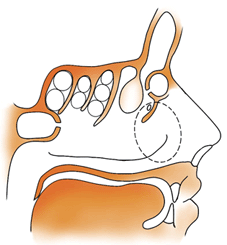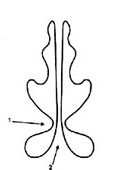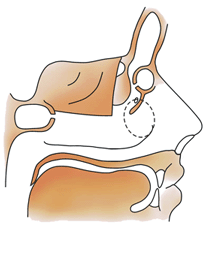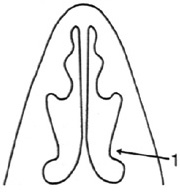



A. The inferior turbinate of a big size almost reaches the nasal septum, that demarcates the inferior and middle meatus
B. The big inferior turbinate lifts the main airstream into the middle meatus, to which all paranasal sinuses are opened
NASAL AERODYNAMICS and RHINOSINUSITISES
Relationship between two parallel respiratory structures in the nose
The functionality of the small ostiums of the nasal sinuses
The real significance of the limen nasi
VARIANTS OF NASAL AERODYNAMICS
NORMOGRAM OF NASAL AERODYNAMICS
PHYSIOLOGICAL BRIDGE REPRESENTED BY THE NASAL VALUE
SURGICAL RECONSTRUCTION OF NASAL AERODYNAMICS
SEPTOPLASRY UNDER CONTROL OF NASAL AERODYNAMICS
CONTRAINDICATION TO SEPTOPLASTY
PROTECTION OF THE INFERIOR NASAL PASSAGE FROM INSPIRATION
THE INSIDIOUSNESS OF THE UNILATERAL "SOUTHERN" NASAL AERODYNAMICS.
SNORING WHEN NASAL RESPIRATION IS SAVED.


 |
Feasible measures of the individual defence against infection by Severe Acute Respiratory Syndrome - SARSDanger of infection by Severe Acute Respiratory Syndrome (SARS) is programmed, when there is disorder of nasal aerodynamics. Yuri P. Uliyanov. The Medical Center AGAMY, Moscow Russia (tel: 219-9110) | |||
Nowadays, the threat of spreading of Severe Acute Respiratory Syndrome (SARS) - Atypical pneumonia or Hongkong influenzae continues, because, the nature of this fatal illness is learned not quite enough.Therefore, there is no effective therapy and reliable defend against of this disease and so, like the unique known remedy for protection from the virus of SARS recognizes the gauze mask onto the mouth and nose. As a result, the number of dead from this disease already has achieved
more than 200 and infected more than 4000 (in China, Singapore, Canada,
USA, Philippines and many others).
As is known, the basic protective mechanism of the respiratory ways
is the mucociliary clearance (transport) which one in the form of
mucus film covers a mobile cilia of the epithelium of mucosa of the
nose, throat, trachea and bronchuses.
As a result, when outsideat is 15 degrees below zero, into the
throat the air enters with heating until 25 degrees above zero and
during the day the nasal mucose selects 500.0 ml. of the fluid for
humidification of the inspired air.
  About efficiency of such defence of the mucociliary clearance
efficacy using of the gauze masks onto the mouth and nose testifies,
because, they do not defend from viruses, but very effectual protects
the mucociliary clearance from any cooling, drying up and dust
contents, and this indeed often guards the people against infection
of SARS.
As a result, when outside is 15 degrees below zero in the throat the air enters with cold temperature below zero too, and drying up and dust content of the mucosa depends from quality of the ambient air. This can lead to overcooling and auscultation of the mucosa especially into the inferior meatus and pharynx to such extend, that the mucociliary clearance is stopping. As a result, the mucosa of the nose and pharynxe become so
defenceless, that even the saprophytic flora, which harmless for
healthy human mucosas, becomes aggressive-traumatizing down to
development of an inflammation in the form of acute respiratory
disease, which one proceeds particularly painfully.
  Such defencelessness of the nasal mucosa with the Southern type
of nasal aerodynamics (STA) is significant facilitates fault of it
by the virus of SARS.
More severe group of the heightened risk is made by the persons with the unilateral STA, when on the counter half of the nose there is the NTA (Fig. 3), because, it is produced owing to the shorter distance until the nasopharynxes along the inferior meatus and therefore the respiration in these cases occurs only through the Southern half of the nose, that leades to its double overloading with the even major damage of the mucociliary clearance.  Accordingly, acute respiratory disease to these persons
development more active and the respiratory infection of SARS is more
aggressive too.
1- In the protection of the mucosa of the inferior meatus and pharynx from overloading by any cooling, desiccation or dust content and 2- in the medical help for the restoration of the mucociliary
clearance activity.
Such reconstruction of nasal aerodynamics is the most required to the unilateral Southern type, because, the plastic operation at one side of the nose can restore the normal respiration on the both sides, at once, that considerably improves stability these people to catchig cold and infection by SARS. In the cases with the STA on two sides, the reconstruction of nasal aerodynamics at each half is required, that becomes necessary, when there are the apart expressed forms of aerodynamics violation. However, at the transition forms of nasal aerodynamics which are between the STA and the Northern type (which one occurs more often) defence of the nasal and pharynx mucosa with medicinal support of its function can be quite successfuly to restore and support of protective properties of the mucociliary clearance, that reduces danger of catarrhal diseases and improves stability to SARS. That is why, currently, when the most of people a character of their nasal aerodynamics do not know yet, it is necessary to suppose for them the Southern type and for increase of their resistance to infection by SARS, the measure for defence of the mucociliary clearance against overcooling, overdrying and dust content are necessary, together with medicinal aid for rising and maintaining of its activity. The individual measures for the prophylaxis and defence against of SARS are the following: 1. The gauze mask onto the mouth and nose, which one broad is used and provide quite enough wetting and warming of the inspired air, that keeps protective properties of the mucociliary clearance of the respiratory ways mucosa against of the viruses and bacterias; 2. Instillation of vegetable oil into the nose (2-3 times a day) as well promotes to defence the mucosa from drying up and cooling, and so, to preservation activities of the mucociliary clearance; 3. Instillation into the nose of anti-inflammatory drops provide
particulary favourable influence upon activity of the mucociliary
clearance and protective properties of the nasal and pharynx mucosas.
4.Protectives properties of the mucociliary clearance is
considerably activated and healed by mucous-active medicaments of
direct and indirect agency.
A) The medicament of directly agency is acting through the superficial
contacts with the nasal and pharynxes mucosa: Cysteine, Trypsine, Jod,
Physiological or Hypertonical solutions etc.
B) ) Mucous-active medications of indirect agency are secreted
from the respiratory mucosa, that very good restores and well
activates the mucociliary clearance.
5. Moderate exercise stresses in the every morning for an ventilation of the paranasal sinuses is necessary to liquidate stagnant processes into them. 6. Administration of vitaminized complexes and anti-virus drugs as well is quite justified. Sharp warning: All medicines, phytoncides, foodstuffs and spices, which one can
dry the mucosa of respiratory ways are counterindicated.
Conclusions: 1. Gauze mask onto the mouth and nose is really defence against infection by SARS (Severe Acute Respiratory Syndrome), because, it very effectual safeguards the mucociliary clearance of the respiratory ways from any cooling, drying up and dust contents like the Northern type of nasal aerodynamics. However, the Southern type of nasal aerodynamics heightens danger of infection by SARS, because, it too much weakens the mucociliary clearance. 2. Northern type of nasal aerodynamics is capable to defend a person from infects with SARS or to reduce its aggressiveness, but the Southern type of nasal aerodynamics creates the high-risk group, which is programmed to the heightened danger of infection by SARS. 3. Nowadays, when the most of the people do not know yet about their type of nasal aerodynamics, it is necessary to suppose that they have the Southern type and so, for increase of their stability to SARS, the measures for protection of the mucociliary clearance against overcooling, overdrying and dust content, and also, medicinal assistance on rising and keeping up of its protective function by the mucus-active drugs direct and indirect agency are necessary. 4. Medicaments and foodstuffs (garlic, lemon, oil of sea-buckthorn etc.), dry up of the nasal and pharynxes mucosa and also smoking, chilling and impaired organism weaken activity of the mucociliary clearance and so, they are extremely counterindicatived, because they increase danger of infection by SARS. REFERENCES: Uliyanov Y.P. Relaytions bitween bronchial-pulmonary conditions and nasal aerodynamics. Vestnic of the Center of Endosurgery and Lithotripsy, Moscow, 1997; 1: 32-37. (In Russian). Atkarskaya, A.A., On the physiology of paranasal sinuses. - Zhurnal ushnykh, nosovykh i gorlovykh boleznei, 1925, No.5-6, pp.274-295 [in Russian]. Bachmann, W., Technik und Bedeutung der Funktionsprüfung des Osteun maxillare. - HMO (Berl.), 1978, vol.26, pp.25-27. Cole, R., Some aspects of temperature, moisture and heat relationships in the upper respiratory tract. - J,Laryngol.Otol., 1953, no.67, pp.449-456. Ingelstedt, S., Studies on the conditioning of air in the respiratory. - Acta Otolaryngol., 1956, vol.131, pp.1-10. Likhachev, A.G., in: Diseases of ear, throat, and nose. Moscow, 1947, 374 pp. [in Russian]. Palchun, V.T., Yu.A.Ustyanov, and N.D.Dmitriyev, Paranasal sinusiti-des. Moscow, 1982, 150 pp. [in Russian]. Piskunov, G.Z., in: Materals of the international symposium "Allergic and infections rhino-sinusitides" held in Jerusalem, 1994. - Rossiiskaya rinologiya, 1994, no.2, pp.91-94. Piskunov, S.Z., Physiology and pathophysiology of nose and paranasal sinuses. - Rossiiskaya rinologiya, 1993, no.1, pp.19-38. [in Russian]. Sagalovich, B.M., Physiology and pathophysiology of the upper respi-ratory tract. 1967, 328 pp. [in Russian]. Stucker FJ, Smith TE. Pitfalls in management of defects of bony dorsum and cartilaginous vault. Arch Otolaryngol 1976; 102: 695. Stucker F.J. Management of the scoliotic nasal.J.Laryngoscope.1982;Vol.92, 2:128. Stucker.F.J. Contemporary septal nasal surgery. J. Rossiyskaya Rinologya. 1997; 1:4-8. ( In Russian ). Stucker FJ, Ansel TE. A case against nasal packing Laryngoscope 1987; 88: 1314. Yedinak, E.N., A method of the analysis of air exchange within the Highmore sinus in highmoritides. Patent of USSR no.187009.
Uliyanov Y.P., Polivanov P.P. Russian patents ¹¹ 1,572,505; 1,602,472,(1988). (In Russian). Uliyanov Y.P. Nose aerodynamics. Arch. Otolaryngol. Head Neck Surg. 1995; 121: 352 Uliyanov Y.P. Nose aerodynamics. Jor. Vrach, Moscow, 1996; 11: 39-40. (In Russian). Ulyanov Y.P. Normogram of nasal aerodynamics. Jr. Russian Rhinology. 1996, No 5 : 15-7. [in Russian]. Uliyanov Y.P. Method reconstruction of nasal aerodynamics. Jor. Vrach, Moscow,1997; 7: 31-33. (In Russian). Ulyanov Y.P. Method of reconstruction of the protective function of the nose. Russian patent ¹95105086. Ulyanov Y.P. Normogram of nasal aerodynamics. XYI World Congr. Of Otolar. Head Neck Surg.(Sydney, Australia, 2-7 March, 1997: 1603-1607. Uliyanov Y.P. Physiological bridge represented by the nasal valve and its variants. XVI World Congress of Otolaryng. Head and Neck Surg. Sydney, 1997.p. 1597-601. Uliyanov Y.P. Surgical reconstruction of nasal aerodynamics. XYI World Congr. Of Otolar. Head Neck Surg.(Sydney, Australia, 2-7 March, 1997: 1591-1595. Uliyanov Yu. Clinical Medicine (Reference book of a practicing physician). MSPI, Moscow, 1997,V-2:1103 - 1152. (In Russian). Uliyanov Y.P. Relaytions bitween bronchial-pulmonary conditions and nasal aerodynamics. Vestnic of the Center of Endosurgery and Lithotripsy, Moscow, 1997; 1: 32-37. (In Russian). Uliyanov Y.P. Clinical manifestations of the Variants of the Nasal Aerodynamics. Otolaryng. HNS 1998; 119: 2: 152-3. Uliyanov Y.P. On Contraindication to Septoplasty. Otolaryngology-Head and Neck Surgery -August 1998; 119 (2): 153-4. Uliyanov Y.P The local REASONS(CAUSES) and consequences of snore. International Medical Journal. 1999, 1-2:108-10. (In Russian). Uliyanov Y Septoplasty under control of nasal aerodynamics Æóðíàë ÂÐÀ×, 2000,6: 28-31. . (In Russian). Uliyanov Y.P. The insidiousness of unilateral "southern" type of nasal aerodynamics. 115N- The XYII World Congr. of Otorhinolaringology. (IFOS,Sept.28-Oct.3,2002,Cairo, Egypt.) Uliyanov Y.P. Peculiarities of the therapy of the chronic ethmoiditis when treating "Silver People". 113N-o The XYII World Con. of Otorhinolaringology. (IFOS,Sept.28-Oct.3,2002,Cairo, Egypt) Uliyanov Y.P. Septoplasty under control of nasal aerodynamics. 116N-o The XYII World Con.of Otorhinolaringology.(IFOS,Sept.28-Oct.3,2002,Cairo, Egypt Uliyanov Y.P. Snoring at the saved nasal respiration. 114S-o The XYII World Con. of Otorhinolaringology. (IFOS,Sept.28-Oct.3,2002,Cairo, Egypt.) | ||||
|
|
||||

